Introduction
As we all know cells are the structural and functional units of the organism. The first discovery of a cell was made in 1665 by scientist Robert Hooke. Cells are the units that carry metabolic activity and hereditary information. According to the kingdom of the organism, cells are two types animal cells and plant cells. The plant cell structure is simply discussed in detail in my article.
The cells can only be seen with the help of a microscope. The average size varies from 0.1 micrometers to 100 micrometers. The cells are different shapes like round, rectangular, cylinders, columnar, etc. (2) & (3).
Interesting facts
- The diameter of the largest cell is about 17 cm and the diameter of the smallest cell is about 0.1 micrometers.
- The length of nerve cells in mammals is up to 1 m.
Plant cell
Like animals, plants are also made up of cells that are also eukaryotic. That is, plant cells are made up of a well-organized nucleus and cell organelles. Plant cells are the units that carry the metabolic and hereditary information of the plant body. Plant cells contain a type of pigment called the chloroplast. It is an important cell organelle of plant cells. Plants produce food in the process of photosynthesis by these cell organelles.
Acetabularia is the largest single-celled plant cell. Its length is about 5 to 10 cm. This plant cell is visible to the naked eye. The large cell of a multicellular plant is a fiber in the bark of a plant called Ramie. Its length is about 55 cm (1).
Plant cell properties
Some features of plant cells are as follows
1. A plant cell has a hole in the cell walls which is called plasmodesmata.
2. Plant cells have colorful plastids (such as chloroplast).
3. The cell wall is present in plant cells.
4. In plant cells, the nucleus is located on one side of the cell.
5. Plant cells do not have a cell organelle called the centrosome.
6. The presence of lysosomes in these cells is rare.
7. Plant cells do not have microvilli.
8. The number of vacuoles in plant cells is small but much larger.
9. Plant cells do not usually form a pinocytic hole (4).
Structure of plant cell
Cell structure and function are quite complex. A plant cell consists mainly of two parts the cell covering and protoplasm. The structural features and functions of different parts of an ideal plant cell are described below (3).
Cell covering
There are two types of cell covering
Cell wall
The cell membrane.
1. Cell wall
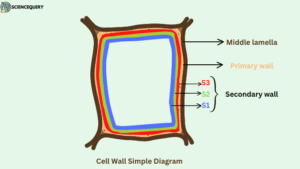
Click here to download a simple diagram of the cell wall
A cell wall is a cellulose-formed inert, elastic, and permeable membrane outside the cell membrane of a plant cell. During cell origin and growth, three layers are formed in the cell wall of the plant cell. The thin and soft cell wall that forms during cell division is called the middle lamella made of pectin. The primary cell wall is the layer formed by the accumulation of organic matter such as cellulose, lignin, and suberin in the next part of the middle lamella. The thick, solid layer of cellulose and hemicellulose that accumulates on the inside of the primary cell wall is called the secondary cell wall. The cell wall of a plant cell is made up of numerous pores, which form cytoplasmic links with the surrounding cells. This is called cytoplasmic connection or plasmodesmata.
Function
1. The function of a cell wall is to protect the cell from mechanical injury.
2. Cell wall maintains the shape of the cell and provides firmness.
3. It acts as a permeable veil and helps move water and other substances (3) & (4).
2. Cell membrane
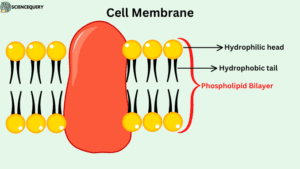
Click here to download a simple diagram of the cell membrane
A living, semi-permeable, and elastic single membrane made up of protein and lipids that surround the protoplasm is called the cell membrane. The cell membrane of a plant cell is made up of two phospholipid layers.
Function
1. The cell membrane protects the other organelles inside the cell.
2. As a semi-permeable veil, this veil allows certain substances to move.
3. The function of the cell membrane is to protect the protoplasm and give shape to the cell.
4. The cell membrane controls the exchange of various organic and inorganic matter inside or outside the cell (1) & (3)
Protoplasm
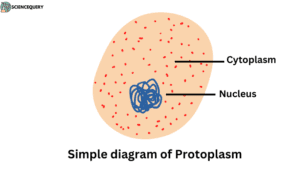
Click here to download a simple diagram of protoplasm
It is a semi-liquid, colloidal, and jelly-type living part located inside the cell membrane. It is divided into two main parts.
Nucleus
Cytoplasm.
1. Nucleus
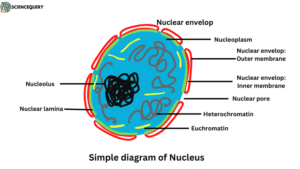
Click here to download a simple diagram of a nucleus
The nucleus is the largest, densest, single-membered, almost spherical part of the protoplasm. It consists of a nuclear membrane, nucleoplasm, nucleolus, and nuclear reticulum. The outer layer of the nucleus has two layers of organic membrane called the nuclear membrane. The dark-colored part of the nucleus is called the nucleolus. A protoplasmic fluid surrounded by a nuclear membrane is called a nucleoplasm. The nuclear reticulum is chromatin wrapped in the nucleus.
Function
1. Nucleus plays an important role in maintaining the metabolism of the cell. That is why it is called the brain of the cell.
2. The DNA of the chromosome located in the nucleus carries the characteristics of the species from one generation to the next.
3. The nucleus plays an important role in cell division (3) & (5).
2. Cytoplasm
The remaining living part of the protoplasm without the nucleus is called the cytoplasm. It is a colorless, opaque, jelly-like, and semi-liquid substance. The cytoplasm has two parts hyaloplasm and trophoplasm.
Hyaloplasm contains non-living objects (water, ions, amino acids, sugars, etc.) in a floating state.
Trophoplasm is of two types. Such as cytoplasmic inclusions and cell organelles. A reticular structure made up of protein fibers and ducts gives the shape of a cytoplasm, called a cytoskeleton
Function
1. Different physiological processes of metabolism occur in the cytoplasm.
2. The cytoplasm coordinates the function of different cellular organs.
3. The cytoplasm helps maintain cell structure (4).
Cell organelles of plant cell
Plant cell organelles are located in the cytoplasm. The cellular organelles of plant cells are mitochondria, Golgi bodies, plastid, endoplasmic reticulum, ribosome, vacuole, and microtubules. These are given in detail below.
1. Mitochondria
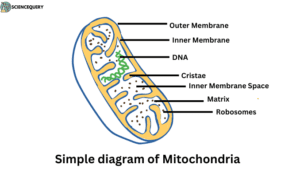
Click here to download a simple diagram of mitochondria
The mitochondria are the cellular organelle enclosed by a double membrane scattered in the cytoplasm of the plant cell. Mitochondria are different shapes like rods, spheres, ovals, or threads.
Function
1. Mitochondria releases the energy needed to control the various biological functions of cells. So it is called the powerhouse of the cell.
2. It converts the static energy of food into ATP (useful power of cells).
3. Oxidation of amino acids occurs in mitochondria.
4. The function of mitochondria is to regulate cellular function by storing calcium in the cytoplasm (4).
2. Golgi bodies or Golgi apparatus
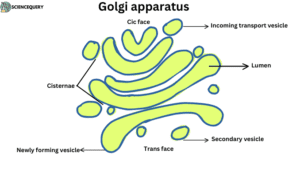
Click here to download a simple diagram of the Golgi apparatus
The Golgi body or apparatus is the single-membrane round or cylindrical densely enclosed organelle near the nucleus that assists in secretion. The organ-less cytoplasmic part around it is called the zone of exclusion. The Golgi body or apparatus of a plant cell is called a dictyosome. Plant cells have hundreds of Golgi bodies or apparatus.
Function
1. The function of Golgi bodies is to participate in the secretion of various elements.
2. Golgi bodies take proteins from the endoplasmic reticulum and attach sugars to them.
3. Golgi bodies help in the collection and transport of secretion elements from the cell (4).
3. Plastid
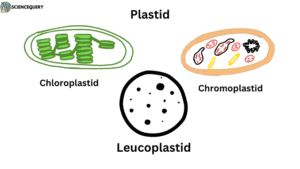
Click here to download a simple diagram of plastids simple diagram
A cytoplasmic organelle surrounded by a double membrane in plant cells that participates in food synthesis, food storage, and pigmentation is called a plastid. Plastids are divided into three parts according to the presence of pigment. These are –
1. Chloroplastid: It contains mainly green chlorophyll a and b pigments. These plastids help in photosynthesis.
2. Chromoplastid: These plastids contain red, orange, or yellow carotenoid pigments. Chromoplastid is present in colorful flowers, carrots, tomatoes, etc.
3. Leucoplastid: These are pigment-less colorless plastids. These are found in the roots of plants.
Structure
Plastids in different plants are in different shapes such as round, oval, lattice, and twisted ribbon. It is covered with two single membranes. The space between the two membranes is called periplastidial space. The homogeneous, jelly-type substance inside the membrane is called the stroma. The stroma contains starch, protein grains, ribosomes, DNA, RNA enzymes, vitamins, and minerals. The flattened bladder-shaped thylakoids are located in the stroma. The layer that is formed when the thylakoids are stacked together is called grana. The long thylakoid part that connects the two grana is called the stroma lamellae.
Function
1. The light reaction of photosynthesis occurs in the grana region of chloroplastid.
2. The light-independent phase or carbon reaction occurs in the stroma region of chloroplastid.
3. The color of flowers and fruits are colorful for the Chromoplastid.
4. Leucoplastid stores starch, protein, and lipids (1) & (5).
4. Endoplasmic reticulum
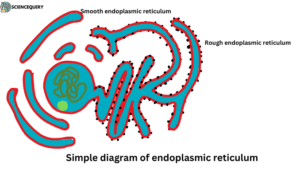
Click here to download a simple diagram endoplasmic reticulum (ER)
These are cylindrical, branched cellular organelles. The organelle that divides the cytoplasm into numerous cells, extending from the nuclear membrane to the cell membrane in the cytoplasm, is called the endoplasmic reticulum. These cellular organelles have a single membrane. The endoplasmic reticulum has two types. These are rough endoplasmic reticulum and smooth endoplasmic reticulum.
Function
1. The function of the endoplasmic reticulum is to produce different types of cellular organelle.
2. The endoplasmic reticulum modifies the structure of the newly formed protein to make it suitable for specific functions and to transport it to specific locations.
3. Rough endoplasmic reticulum transport proteins.
4. Smooth endoplasmic reticulum produces lipids and membranes (5).
5. Ribosome
It is a granular cell organelle without a membrane. These are scattered in the cytoplasm. The ribosome is made up of proteins and RNA. It is a particle made up of ribonucleoprotein located at the base of the endoplasmic reticulum.
Function
1. The main function of the ribosome is to synthesize proteins. The ribosome forms proteins under the direction of mRNA. That is why the ribosome is called the protein factory of the cell.
2. Ribosomes take part in fat metabolism (3).
6. Vacuole
The numerous small and large fluid holes in the cytoplasm of a plant cell are called vacuoles. The vacuoles of plant cells are surrounded by a membrane of lipoproteins. Vacuoles are large in plant cells.
Structure
The vacuole is covered by a single membrane. It contains cell sap. The vacuoles of a mature plant cell are large in size. Vacuoles in plant cells are located in most places. As a result, the cytoplasm moves toward the cell membrane. This position of the cytoplasm between the cell membrane and vacuole is called the primordial utricle.
Function
1. The vacuole plays an important role in the excretion of plants.
2. Anthocyanin pigment, which is responsible for the blue or pink color of the flowers, is located in the vacuole.
3. It maintains the shape of the cell.
4. vacuole helps in adding pollen to the flowers (4) & (5).
7. Microtubules
There are several tiny ducts in the cytoplasm of plant cells called microtubules.
Function
They transport water, ions, and tiny molecules in the cell and help in the formation of spindle fibers and asters during cell division (3).
8. Cytoplasmic inclusions
Besides the cell organelles, there are also found inert substances in plant cells. These are called cytoplasmic inclusions. These are different types of stored food items like starch, glycogen, etc; some types of secretions like nectar, pigments, enzymes, etc; and waste materials like tannins, latex, organic acids, etc. (2).
